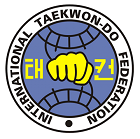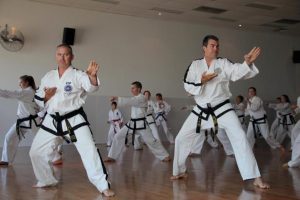ITF Patterns
While ITF Patterns, assembled by the Founder General Choi Hong Hi, are but one of the many components which make up the composition of Taekwon-Do, so many of the technical aspects are contained within them, which makes them of paramount importance in ITF Taekwondo training.
There are 24 patterns in the official ITF “Chang Hon” syllabus, which represents the 24 hours in a day. The names of these patterns refer to events or important people in Korean history. Features of the patterns may also have historical references, such as the number of moves, the diagram, the way the pattern ends etc.
Chon Ji
(19 moves, left foot returns) Means literally the Heaven the Earth. It is in the Orient, interpreted as the creation of the world or the beginning of human history; therefore, it is the initial pattern played by the beginner. This pattern consists of two similar parts; one to represent the Heaven and the other the Earth.
Dan Gun
(21 moves, left foot returns) Is named after the holy Dan-Gun, the legendary founder of Korea in the year of 2,333 B.C.
Do San
(24 moves, right foot returns) Is the pseudonym of the patriot Ahn Chang-Ho (1876-1938).The 24 movements represent his entire life which he devoted to furthering the education of Korea and its independence movement.
Won Hyo
(28 moves, right foot returns) Was the noted monk who introduced Buddhism to the Silla Dynasty in the year of 686 A.D.
Yul Gok
(38 moves, left foot returns) Is the pseudonym of a great philosopher and scholar Yil (1536-1584) nicknamed the “Confucius of Korea”. The 38 movements of this pattern refer to his birthplace on 38th degree latitude and the diagram represents scholar.
Joong Gun
(32 moves, left foot returns) Is named after the patriot Ahn Joong-Gun who assassinated Hiro-Bumo Ito, the first Japanese governor / general of Korea, known as the man who played the leading part in the Korea-Japan merger. There are 32 movements in this pattern to represent Mr. Ahns age when he was executed at Lui-Shung prison (1910).
Toi Gye
(37 moves, right foot returns)Is the pen name of the noted scholar Yi Hwang (16th century), an authority on neo-Confucianism. The 37 movements of the pattern refer to his birthplace on 37th degrees latitude, the diagram represents “scholar”.
Hwa Rang
(29 moves, right foot returns)Is named after the Hwa-Rang youth group which originated in the Silla Dynasty in the early 7th century. The 29 movements refer to the 29th Infantry Division, where Taekwon-Do developed into its full maturity.
Choong Moo
(30 moves, left foot returns) Was the name given to the great Admiral Yi Soon-Sin of the Yi Dynasty. He was reputed to have invented the first armored battleship (Kobukson) in 1592, which is said to be the precursor of the present day submarine. The reason why this pattern ends with a left hand attack is to symbolize his regrettable death, having no chance to show his unrestrained potential checked by the forced reservation of his loyalty to the king.
Kwang Gae
(39 moves, left foot returns) is named after the famous Gwang-Gae-Toh-Wang, the 19th King of the Koguryo Dynasty, who regained all the lost territories including the greater part of Manchuria. The diagram represents expansion and recovery of lost territory. The 39 movements refer to the first two figures of 391 A.D., the year he came to the throne.
Po Eun
(36 moves, left foot returns) Is the pseudonym of a loyal subject Chong Mong-Chu (1400) who was a famous poet and whose poem “I would not serve a second master though I might be crucified a hundred times”, is known to every Korean. He was also a pioneer in the field of physics. The diagram represents his unerring loyalty to the king and country towards the end of the Koryo Dynasty.
Ge Baek
(44 moves, right foot returns) Is named after Ge-Baek, a great general in the Baek Je Dynasty (660 A.D.). The diagram represents his severe and strict military discipline.
Eui Am
(45 moves, right foot returns) Is the pseudonym of Son Byong Hi, leader of the Korean independence movement on March 1, 1919. The 45 movements refer to his age when he changed the name Dong Hak (Oriental Culture) to Chondo Kyo (Heavenly Way Religion) in 1905. The diagram represents his indomitable spirit, displayed while dedicating himself to the prosperity of his nation.
Choong Jang
(52 moves, left foot returns) Is the pseudonym given to General Kim Duk Ryang who lived during the Yi Dynasty, 14th century. This pattern ends with a left-hand attack to symbolize the tragedy of his death at 27 in prison before he was able to reach full maturity.
Ko-Dang
(39 moves) is the pseudonym of the patriot Cho Man Sik who dedicated his life to the independence movement and education of his people. The 39 movements signify his times of imprisonment and his birthplace on the 39th parallel.
Juche
(45 moves, right foot returns) Is a philosophical idea that man is the master of everything and decides everything, in other words, the idea that man is the master of the world and his own destiny. It is said that this idea was rooted in Baekdu Mountain which symbolizes the spirit of the Korean people. The diagram represents Baekdu Mountain.
Sam-IL
(33 moves, right foot returns) denotes the historical date of the independence movement of Korea which began throughout the country on March 1, 1919. The 33 movements in the pattern stand for the 33 patriots who planned the movement.
Yoo-Sin
(68 moves, right foot returns) is named after General Kim Yoo Sin, a commanding general during the Silla Dynasty. The 68 movements refer to the last two figures of 668 A. D., the year Korea was united. The ready posture signifies a sword drawn on the right rather than left side, symbolizing Yoo Sin’s mistake of following his king’s orders to fight with foreign forces against his own nation.
Choi-Yong
(45 moves, right foot returns) is named after General Choi Yong, Premier and Commander-in-Chief of the Armed forces during the 14th century Koryo Dynasty. Choi Yong was greatly respected for his loyalty, patriotism, and humility. He was executed by his subordinate commanders headed by General Yi Sung Gae, who later become the first king of the Lee Dynasty.
Yon-Gae
(49 moves, right foot returns) is named after a famous general during the Koguryo Dynasty, Yon Gae Somoon. The 49 movements refer to the last two figures of 649 A. D., the Year he forced the Tang Dynasty to quit Korea after destroying nearly 300,000 of their troops at Ansi Sung.
UL-JI
(42 moves, left foot returns) is named after general Ul-Ji Moon Dok who successfully defended Korea against a Tang’s invasion force of nearly one million soldiers led by Yang Je in 612 A.D., Ul-Ji employing hit and run guerilla tactics, was able to decimate a large percentage of the force. The diagram ( L) represents his surname. The 42 movements represents the author’s age when he designed the pattern.
Moon-Moo
(61 moves, left foot returns) honors the 30th king of the Silla Dynasty. His body was buried near Dae Wang Am (Great King’s Rock). According to his will, the body was placed in the sea “Where my soul shall forever defend my land against the Japanese.” It is said that the Sok Gul Am (Stone Cave) was built to guard his tomb. The Sok Gul Am is a fine example of the culture of the Silla Dynasty. The 61 movements in this pattern symbolize the last two figures of 661 A.D. when Moon Moo came to the throne.
So-San
(72 moves, left foot returns) is the pseudonym of the great monk Choi Hyong Ung (1520-1604) during the Lee Dynasty. The 72 movements refer to his age when he organized a corps of monk soldiers with the assistance of his pupil Sa Myung Dang. The monk soldiers helped repulse the Japanese pirates who overran most of the Korean peninsula in 1592.
Se-Jong
(24 moves, left foot returns) is named after the greatest Korean king, Se-Jong, who invented the Korean alphabet in 1443, and was also a noted meteorologist. The diagram (Z) represents the king, while the 24 movements refer to the 24 letters of the Korean alphabet.
Tong-IL
(42 moves, left foot returns) denotes the resolution of the unification of Korea which has been divided since 1945. The diagram (I) symbolizes the homogenous race.
There are also 2 fundamental exercises, named Saju-Jirugi (Four Direction Punch and Saju-Makgi (Four Direction Block). Saju-Jirugi and Saju-Makgi are basic defence exercises taught to beginners of the Taekwon-Do.
Subscribe to our YouTube channel to see all the patterns and more
General Performance Tips
- Patterns should begin and end at exactly the same spot. This will indicate the performer’s accuracy.
- Correct posture and facing must be maintained at all times.
- Muscles of the body should be either tensed or relaxed at the proper critical moments in the pattern.
- The pattern should be performed in a rhythmic movement with an absence of stiffness.
- Movement should be accelerated or decelerated as necessary.
- Each pattern should be perfected before moving to the next.
- Students should know the purpose of each movement.
- Students should perform each movement with realism.
- Attack and defence techniques should be equally distributed among right and left hands and feet.
ITF Patterns in Competition
Patterns are Judged according to the following criteria:
- Technical Content (5 points)
- Power (5 points)
- Rhythm (5 points)
Technical Content refers to:
- Correct pattern diagram, all steps performed
- Techniques performed at correct height and direction of travel
- Proper tool used for blocking, striking or kicking
- Correct preparation positions
- Correct Stance dimensions and weight distributions
- Appropriate posture and facing
- Correct use of sine wave
- Correct cadence/timing of pattern
- Appropriate start and finish positions
- Correct stepping, pivoting and turning
- Maintaining equilibrium whilst stepping, turning and pivoting
- Remaining stable whilst kicking, including slow movements
- Control of body weight and momentum
- Kihaps performed in appropriate places
Power refers to:
- Correct application of sine wave
- Use of reaction arm
- Appropriate utilization of larger muscle groups, and transfer of body weight
- Acceleration of movements
- The appropriate use of breath for each movement
- Correct strength and timing of breath
Rhythm refers to:
- Timing of the pattern in accordance with encyclopaedia recommendations
- Absence of delayed pauses, or irregular sequences
- Performing the pattern too fast
- Pattern completed from start to finish in one continuous sequence.
All patterns are assessed according to the recommendations of the Founder of Taekwon-Do, General Choi Hong Hi, along with updates made by the International Taekwon-Do Federation.



 Subscribe to our channel
Subscribe to our channel